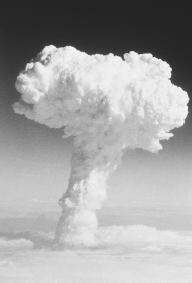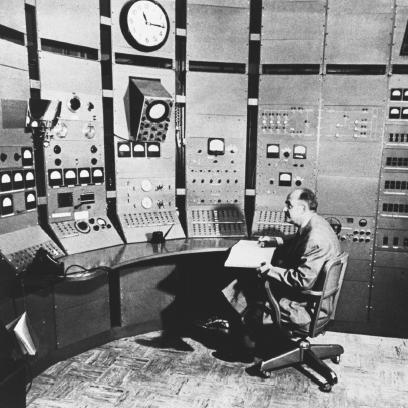Isotopes - How it works
Atoms and Elements
The elements are substances that cannot be broken down into other matter by chemical means, and an atom is the fundamental particle in an element. As of 2001, there were 112 known elements, 88 of which occur in nature; the rest were created in laboratories. Due to their high levels of radioactivity, they exist only for extremely short periods of time. Whatever the number of elements—and obviously that number will increase over time, as new elements are synthesized—the same number of basic atomic structures exists in the universe.
What distinguishes one element from another is the number of protons, subatomic particles with a positive electric charge, in the nucleus, or center, of the atom. The number of protons, whatever it may be, is unique to an element. Thus if an atom has one proton, it is an atom of hydrogen, because hydrogen has an atomic number of 1, as shown on the periodic table of elements. If an atom has 109 protons, on the other hand, it is meitnerium. (Meitnerium, synthesized at a German laboratory in 1982, is the last element on the periodic table to have been assigned a name as of 2001.)
THE NUCLEUS AND ELECTRONS.
Together with protons in the nucleus are neutrons, which exert no charge. The discovery of these particles, integral to the formation of isotopes, is discussed below. The nucleus, with a diameter about 1/10,000 that of the atom itself, makes up only a tiny portion of the atom's volume, but the vast majority of its mass. Thus a change in the mass of a nucleus, as occurs when an isotope is formed, is reflected by a noticeable change in the mass of the atom itself.
Far from the nucleus (in relative terms, of course), at the perimeter of the atom, are the electrons, which have a negative electric charge. Whereas the protons and neutrons have about the same mass, the mass of an electron is less than 0.06% of either a proton or neutron. Nonetheless, electrons play a highly significant role in chemical reactions and chemical bonding. Just as isotopes are the result of changes in the number of neutrons, ions—atoms that are either positive or negative in electric charge—are the result of changes in the number of electrons.
Unless it loses or gains an electron, thus becoming an ion, an atom is neutral in charge, and it maintains this electric-charge neutrality by having an equal number of protons and electrons. There is, however, no law of the universe stating that an atom must have the same number of neutrons as it does protons and electrons: some do, but this is far from universal, as we shall see.
Neutrons
The number of neutrons is variable within an element precisely because they exert no charge, and thus while their addition or removal changes the mass, it does not affect the electric charge of the atom. Therefore, whereas the importance of the proton and the electron is very clear to anyone who studies atomic behavior, neutrons, on the other hand, might seem at first glance as though they are only "along for the ride." Yet they are all-important to the formation of isotopes.
Not surprisingly, given their lack of electric charge, neutrons were the last of the three major subatomic particles to be discovered. English physicist J. J. Thomson (1856-1940) identified the electron in 1897, and another English physicist, Ernest Rutherford (1871-1937), discovered the proton in 1914. Rutherford's discovery overturned the old "plum pudding" model, whereby atoms were depicted as consisting of electrons floating in a positively charged cloud, rather like raisins in an English plum pudding. As Rutherford showed, the atom must have a nucleus—yet protons alone could not account for the mass of the nucleus.
There must be something else at the heart of the atom, and in 1932, yet another English physicist, James Chadwick (1891-1974), identified what it was. Working with radioactive material, he found that a certain type of subatomic particle could penetrate lead. All types of radiation known at the time were stopped by the lead, and therefore Chadwick reasoned that this particle must be neutral in charge. In 1932, he won the Nobel Prize in physics for his discovery of the neutron.
NEUTRONS AND NUCLEAR FUSION.
Neutrons played a critical role in the development of the atomic bomb during the 1940s. In nuclear fission, atoms of uranium are bombarded with neutrons. The result is that the uranium nucleus splits in half, releasing huge

This explains the destructive power in an atomic bomb, as well as the constructive power—providing energy to homes and businesses—in a nuclear power plant. Whereas the chain reaction in an atomic bomb becomes an uncontrolled explosion, in a nuclear plant, the reaction is slowed and controlled. One of the means used to do this is by the application of "heavy water," which, as we shall see, is water made with a hydrogen isotope.
Isotopes: The Basics
Two atoms may have the same number of protons, and thus be of the same element, yet differ in their number of neutrons. Such atoms are called isotopes, atoms of the same element having different masses. The name comes from the Greek phrase isos topos , meaning "same place": because they have the same atomic number,

Also called nuclides, isotopes are represented symbolically as follows: where S is the symbol of the element, a is the atomic number, and m is the mass number—the sum of protons and neutrons in the atom's nucleus. For the stable silver isotope designated as for instance, Ag is the element symbol; 47 its atomic number; and 93 the mass number. From this, it is easy to discern that this particular stable isotope has 46 neutrons in its nucleus.
Because the atomic number of any element is established, sometimes isotopes are represented simply with the mass number, thus: 93 Ag. They may also be designated with a subscript notation indicating the number of neutrons, so that this information can be obtained at a glance without having to do the arithmetic. For the silver isotope shown here, this is written as Isotopes can also be indicated by simple nomenclature: for instance, carbon-12 or carbon-13.
Stable and Unstable Isotopes
Radioactivity is a term describing a phenomenon whereby certain materials are subject to a form of decay brought about by the emission of high-energy particles or radiation. Forms of particles or energy emitted in radiation include alpha particles (positively charged helium nuclei); beta particles (either electrons or subatomic particles called positrons); or gamma rays, which occupy the highest energy level in the electromagnetic radiation emitted by the Sun. Radioactivity will be discussed below, but for the present, the principal concern is with radioactive properties as a distinguishing factor between the two varieties of isotope.
Isotopes are either stable or unstable. The unstable variety, known as radioisotopes, are subject to radioactive decay, but in this context, "decay" does not mean what it usually does. A radioisotope does not "rot"; it decays by turning into another isotope of the same element—or even into another element entirely. (For example, uranium-238 decays by emitting alpha particles, ultimately becoming lead-206.) A stable isotope, on the other hand, has already become what it is going to be, and will not experience further decay.
Most elements have between two and six stable isotopes. On the other hand, a few elements—for example, technetium—have no stable isotopes. Twenty elements, among them gold, fluorine, sodium, aluminum, and phosphorus, have only one stable isotope each. The element with the most stable isotopes is easy to remember because its name is almost the same as its number of stable isotopes: tin, with 10.
As for unstable isotopes, there are over 1,000, some of which exist in nature, but most of which have been created synthetically in laboratories. This number is not fixed; in any case, it is not necessarily important, because many of these highly radioactive isotopes last only for fractions of a second before decaying to form a stable isotope. Yet radioisotopes in general have so many uses, in comparison to stable isotopes, that they are often referred to simply as "isotopes."
Understanding Isotopes
Before proceeding with a discussion of isotopes and their uses, it is necessary to address a point raised earlier, when it was stated that some atoms do have the same numbers of neutrons and protons, but that this is far from universal. In fact, nuclear stability is in part a function of neutron-to-proton ratio.
Stable nuclei with low atomic numbers (up to about 20) have approximately the same number of neutrons and protons. For example, the most stable and abundant form of carbon is carbon-12, with six protons and six neutrons. Beyond atomic number 20 or so, however, the number of neutrons begins to grow: in other words, the lowest mass number is increasingly high in comparison to the atomic number.
For example, uranium has an atomic number of 92, but the lowest mass number for a uranium isotope is not 184, or 92 multiplied by two; it is 218. The ratio of neutrons to protons necessary for a stable isotope creeps upward along the periodic table: tin, with an atomic number of 50, has a stable isotope with a mass number of 120, indicating a 1.4 to 1 ratio of neutrons to protons. For mercury-200, the ratio is 1.5 to 1.
The higher the atomic number, by definition, the greater the number of protons in the nucleus. This means that more neutrons are required to "bind" the nucleus together. In fact, all nuclei with 84 protons or more (i.e., starting at polonium and moving along the periodic table) are radioactive, for the simple reason that it is increasingly difficult for the neutrons to with stand the strain of keeping so many protons in place.
One can predict the mode of radioactive decay by noting whether the nucleus is neutron-rich or neutron-poor. Neutron-rich nuclei undergo beta emission, which decreases the numbers of protons in the nucleus. Neutron-poor nuclei typically undergo positron emission or electron capture, the first of these being more prevalent among the lighter nuclei. Elements with atomic numbers of 84 or greater generally undergo alpha emission, which decreases the numbers of protons and neutrons by two each.
Thanks for getting us with the science of subatomic particles and concepts of isotopes!